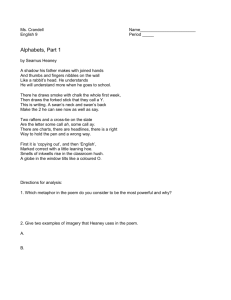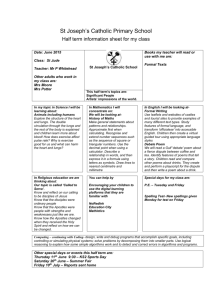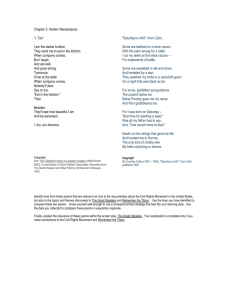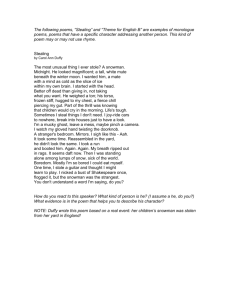Oral Commentary Prep.: Flash Cards
advertisement
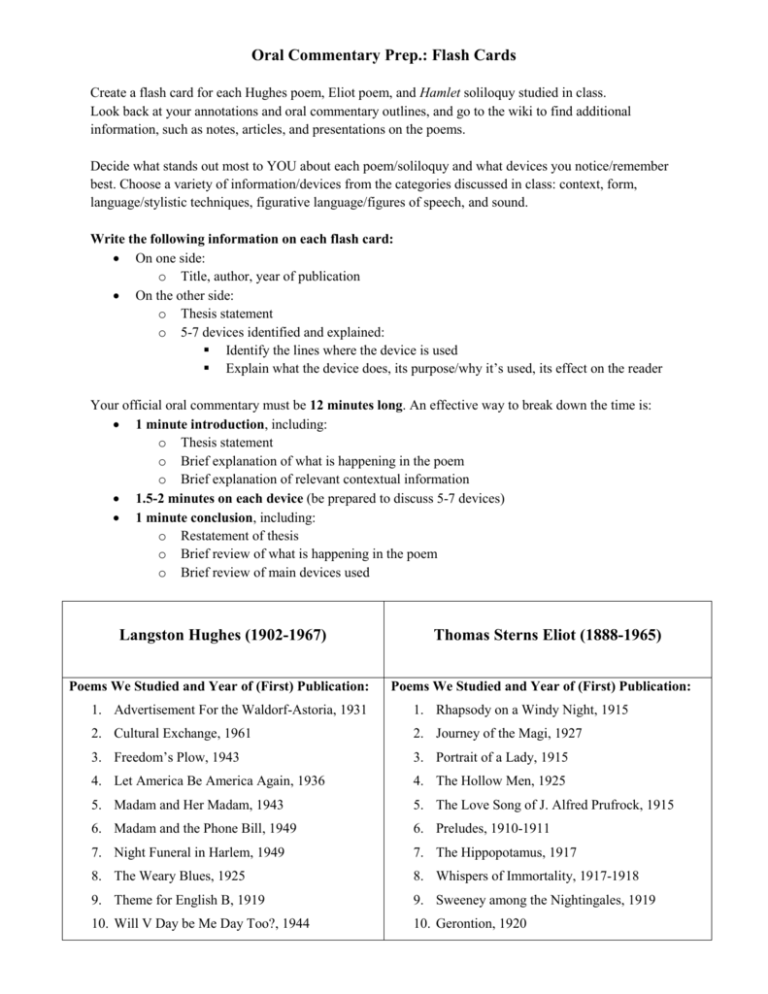
Oral Commentary Prep.: Flash Cards Create a flash card for each Hughes poem, Eliot poem, and Hamlet soliloquy studied in class. Look back at your annotations and oral commentary outlines, and go to the wiki to find additional information, such as notes, articles, and presentations on the poems. Decide what stands out most to YOU about each poem/soliloquy and what devices you notice/remember best. Choose a variety of information/devices from the categories discussed in class: context, form, language/stylistic techniques, figurative language/figures of speech, and sound. Write the following information on each flash card: On one side: o Title, author, year of publication On the other side: o Thesis statement o 5-7 devices identified and explained: Identify the lines where the device is used Explain what the device does, its purpose/why it’s used, its effect on the reader Your official oral commentary must be 12 minutes long. An effective way to break down the time is: 1 minute introduction, including: o Thesis statement o Brief explanation of what is happening in the poem o Brief explanation of relevant contextual information 1.5-2 minutes on each device (be prepared to discuss 5-7 devices) 1 minute conclusion, including: o Restatement of thesis o Brief review of what is happening in the poem o Brief review of main devices used Langston Hughes (1902-1967) Poems We Studied and Year of (First) Publication: Thomas Sterns Eliot (1888-1965) Poems We Studied and Year of (First) Publication: 1. Advertisement For the Waldorf-Astoria, 1931 1. Rhapsody on a Windy Night, 1915 2. Cultural Exchange, 1961 2. Journey of the Magi, 1927 3. Freedom’s Plow, 1943 3. Portrait of a Lady, 1915 4. Let America Be America Again, 1936 4. The Hollow Men, 1925 5. Madam and Her Madam, 1943 5. The Love Song of J. Alfred Prufrock, 1915 6. Madam and the Phone Bill, 1949 6. Preludes, 1910-1911 7. Night Funeral in Harlem, 1949 7. The Hippopotamus, 1917 8. The Weary Blues, 1925 8. Whispers of Immortality, 1917-1918 9. Theme for English B, 1919 9. Sweeney among the Nightingales, 1919 10. Will V Day be Me Day Too?, 1944 10. Gerontion, 1920 Langston Hughes (1902-1967) Movements/Styles: Thomas Sterns Eliot (1888-1965) Movements/Styles: Harlem Renaissance Modernist Modernist Symbolist Jazz/Blues Imagist “Negro Dialect” Stream of Consciousness Iambic Tetrameter Quatrains Major Themes: Major Themes: Social Activism Isolation/Alienation Racism/Segregation Metaphysical: Decay/Death, Racial Pride Patriotism Lust/Sex Communism Anti-Semitism Allusions: African American leaders in Allusions: Dante’s Inferno, Shakespeare, The Religion/Christianity Bible, etc. politics, the arts, etc. Personal Life Events that Influenced Writing: Elected class poet in 8th grade Grew up in Midwestern small towns Travelled around Africa and Europe, had Personal Life Events that Influenced Writing: Moved from U. S. and settled in England in 1914 (briefly lived in Paris from 1910-1911) Married Vivienne Haigh-Wood in 1915, separated in 1932 (affair?) extended stay in Paris (early 1920s) Settled in Harlem, New York (late 1920s) Spent time in blues/jazz clubs worldwide Accused of being communist but denied it Married Valerie Fletcher in 1957 Died while undergoing surgery for cancer Died of health problems due to heavy smoking Unfulfilled with Unitarianism, converted to Anglicanism around 1927 Famous Essay: Famous Essay: “The Negro Artist and the Racial Mountain,” 1926 “Tradition and the Individual Talent,” 1919-1920



